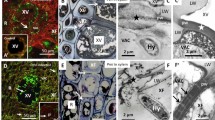Abstract
Rubbing young internodes ofBryonia dioica results in a reduced elongation and an increased diameter of the internodes. In the present study activities of some enzymes involved in the lignification process and levels of lignification were compared in rubbed and non-rubbed internodes. Rubbing caused an increase in the activities of phenylalanine ammonia-lyase and soluble and ionically- and covalently-bound cell wall peroxidases. Sensitivity of the covalently-bound wall peroxidase assay was markedly increased if syringaldazine was used as a substrate. Mechanical perturbation induced an increase in lignin, lignin monomer (sinapylic, coniferylic and p-coumarylic alcohols) content and the number of lignifying vessels. Conversely, rubbing resulted in a decrease in cellulose content. The hypothetical interpretation of the thigmomorphogenetic response through cell wall lignification and hence rigidification is consistent with all the presented results. A comparison is possible between this accelerated lignification and induced lignification as a mechanism of disease resistance. the thigmomorphogenetic response inBryonia dioica can be considered as a mechanism of resistance in order to withstand further environmental mechanical perturbation.
Similar content being viewed by others
References
AlibertG and BoudetA (1979) La lignification chez le peuplier I. Mise au point d'une méthode de dosage et d'analyse monomérique des lignines. Physiol Vég 17:67–74
BellA (1981) Biochemical mechanisms of disease resistance. Ann Rev Plant Physiol 32:21–81
BiroRL, HuntER, ErnerT and JaffeMJ (1980) Thigmomorphogenesis: Changes in cell division and elongation in the internodes of mechanically perturbed or ethreltreated bean plants. Ann Bot 45:655–664
BireckaD and MillerA (1974) Cell wall and protoplast isoperoxidases in relation to injury, indolacetic acid, and ethylene effects. Plant Physiol 533:569–574
BlandD and ScurfieldG (1964) The chemistry of reaction wood. IV. The distribution and nature of lignin in seedlings of hardwood. Holzforschung 18:161–166
BoyerN, DesbiezM-O, HofingerM and GasparTh (1983) Effect of lithium on thigmomorphogenesis inBryonia dioica. Ethylene production and sensitivity. Plant Physiol 72: 522–525
BoyerN, GasparTh and LamondM (1979) Modifications des isoperoxydases et de l'allongement des entre-noeuds de Bryone à la suite d'irritations mécaniques. Z Pflanzenphysiol 93:459–470
DeJaegherG, BoyerN and GasparTh (1983) Intervention d'acides phénoliques dans la résponse thigmomorphogénétique deBryonia dioica. Groupe Polyphénols, Bulletin de laison 11:158–163
FreudenbergK, ReznikH, BoesenbergH and RasenackD (1952) Das an der Verholzung beteiligte Fermentsystem. Chem Ber 85:641–647
GalstonAW and DaviesPJ (1969) Hormonal regulation in higher plants. Science 163:1288–1297
GoldbergR, CatessonA-M and CzaninskiY (1983) Some properties of syringaldazine oxidase, a peroxidase specifically involved in the lignification process. Z Pflanzenphysiol 110:267–279
GrandC and RanjevaR (1979) La lignification chez le peuplier. III. Variation du niveau d'activité d'enzymes impliquées dans la biosynthèse des monomères en fonction du degré de lignification et de la nature des tissus. Physiol Vég 17:433–444
GrossGG, JanseC and ElstnerEF (1977) Involvement of malate, monophenols, and the superoxide radical in hydrogen peroxide formation by isolated cell walls from horseradish (Amoracia lapathifolia Gilib.). Planta 136:271–276
HarkinJM and ObstJR (1973) Lignification in trees: Indication of exclusive peroxidase participation. Science 180:296–298
HarrisPJ and HartlyRD (1976) Detection of bound ferulic acid in cell walls of the Graminae by ultraviolet fluorescence microscopy. Nature 259:508–510
HofingerM, ChapelleB, BoyerN and GasparTh (1979) GC-MS identification and titration of IAA in mechanically perturbedBryonia dioica. Plant Physiol 63 S: 52
JaffeMJ (1973) Thigmomorphogenesis: The response of plant growth and development to mechanical stimulation with special reference toBryonia dioica. Planta 114:143–157
JohnsonDB, MooreWE and ZankLC (1961) The spectrophotometric determination of lignins in small wood samples. TAPPI 44:793–798
LetouzéR (1975) Croissance d'un bourgeon axillaire chezSaliz babylonica L. et activité phénylalanine ammoniac-lyase. Planta 123:155–162
MacnicolPK (1966) Isoperoxidases of the Alaska pea (Pisum sativum L.) Arch Biochem Biophys 117:347–356
MäderM, MeyerY and BoppM (1975) Lokalisation der Peroxidase Isoenzyme in Protoplasten und Zellwänden vonNicotiana tabacum L. Planta 122:259–268
MäderM, UngemachJ and SchlossP (1980) The role of peroxidase isoenzyme groups ofNicotiana tabacum in hydrogen peroxide formation. Planta 147:467–470
MarigoM and BoudetAM (1980) Relation polyphénols-croissance, lignification et limitation de croissance chezLycopersicum esculentum Physiol Plant 49:425–430
RhodesM and WooltortonL (1973) Stimulation of phenolic acid and lignin biosynthesis in swede root tissue by ethylene. Phytochem 12:107–118
RidgeI and OsborneD (1970) Hydroxyproline and peroxidases in cell walls ofPisum sativum: Regulation by ethylene. J Exp Bot 21:843–856
RobertsLW and MillerAR (1983) Is ethylene involved in xylem differentiation? Vistas Plant Sci 6:1–24
RobitailleHA and LeopoldAC (1974) Ethylene and the regulation of apple stem growth under stress. Physiol Plant 32:301–304
RuberyPH and FosketDE (1969) Changes in phenylalanine ammonia-lyase activity during xylem differentiation inColeus and soybean. Planta 87:54–62
SarkanenKV and HergertHL (1971) Classification and distribution. In: SarkanenKV and LudwigCH, eds. Lignins, Occurrence, Formation, Structure and Reactions, 43–94. New York, London, Sydney and Toronto: Wiley Interscience
ShannonMC, BallalSK and HarrisJW (1973) Starch gel electrophoresis of enzymes from nine species ofPolysporus. Amer J Bot 60:96–100
SpectorT (1978) Refinement of the coomasie blue method of protein quantitation. Anal Biochem 86:142–146
VanceCP, KirkTK and SherwoodRT (1980) Lignification as a mechanism of disease resistance. Ann Rev Phytopathol 18:259–288
WestcottRG and HenshawGG (1976) Phenolic synthesis and phenylalanine amonia-lyase activity in suspension cultures ofAcer pseudoplatanus L. Planta 131:67–72
WhitmoreFW (1981) Lignin-protein complex in cell walls ofPinus elliottii: Amino acid constituents. Phytochem 21:315–318
WolterKE and GordonJC (1975) Peroxidases as indicators of growth and differentiation in aspen callus cultures. Physiol Plant 33:219–223
ZobelRW (1973) Some physiological characteristics of the ethylene-requiring tomato mutant diageotropica. Plant Physiol 52:385–389
Author information
Authors and Affiliations
Additional information
Research partly supported by the Belgian FRFC grant 2.9009 to T.G. and by the French CNRS (LA 45, RCP 474).
Rights and permissions
About this article
Cite this article
De Jaegher, G., Boyer, N. & Gaspar, T. Thigmomorphogenesis inBryonia dioica: Changes in soluble and wall peroxidases, phenylalanine ammonia-lyase activity, cellulose, lignin content and monomeric constituents. Plant Growth Regul 3, 133–148 (1985). https://doi.org/10.1007/BF01806053
Received:
Revised:
Accepted:
Issue Date:
DOI: https://doi.org/10.1007/BF01806053




